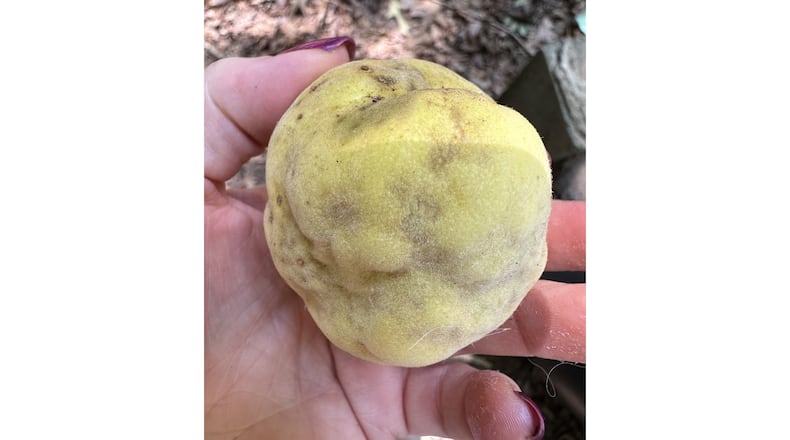Q: My peaches came in very lumpy. Do you have any idea what this is and how to treat it? Allyson Moyer, email
A: The most likely reason for lumpy peaches is stink bug damage. The stink bug inserts its tubular proboscis into a peach and sucks out delicious juice. It visits other peaches but does not wash between meals. As a result, the peach skin heals, but the fungus the stink bug inserted with its dirty nose causes the lumpiness. I have a great link for stink bug identification and control at bit.ly/GAstinkfruit.
Q: We recently had someone redo our front lawn. They removed some flower beds that had liriope in them and laid new TifTuf Bermuda sod. Now we have liriope growing through the new sod where the bed was, as well as some sprouting in other areas of lawn where there was not any before. How do we kill the liriope without killing the newly installed sod? Angie Orem, email
A: From my experience, I think we’re talking about two plants: I have no doubt you have some liriope that is growing into the sod, but the other plant that’s randomly sprouting in the sod I believe is nutsedge. My neighbor laid Emerald zoysia sod this spring, and he has random sprouts of nutsedge in his grass. In a perfect world, sod producers would produce sod that is completely weed-free, but nut grass is terribly invasive and difficult to detect and control. I doubt you could get satisfaction from your sod dealer (but try), so it’s up to you to control the nutsedge yourself. The easiest way is to spot spray with a product containing halosulfuron. The individual use pack is probably all you need. Walk around your lawn and spot spray each leaf of nutsedge that you see. Afterward, apply a half-gallon of water to each spot to take the chemical down to the roots of the plant. Don’t expect immediate results, but about three weeks from now, you should see yellowing and dead nutsedge. Although liriope and nutsedge leaves are similar, halosulfuron does not control liriope, so you’ll have to dig it out with a trowel.
Q: I know it likely is not good gardening, but is it permissible to lay sod over scalped existing grass? Bert McPeeks, email
A: You might lose a lot of sod if you do it your way. Those grass roots under the sod will dry out in a heartbeat if they are not touching the soil underneath. They can’t be “close to” the soil; they have to be touching something to wick water into the young grass plant. You could try rolling the sod, but damage from using a roller too much could be a problem. Do it right and till and level the area before laying sod.
Email Walter at georgiagardener@yahoo.com. Listen to his occasional garden comments on “Green and Growing with Ashley Frasca” Saturday mornings on 95.5 WSB. Visit his website, walterreeves.com, or join his Facebook page at bit.ly/georgiagardener for his latest tips.
About the Author
Keep Reading
The Latest
Featured


